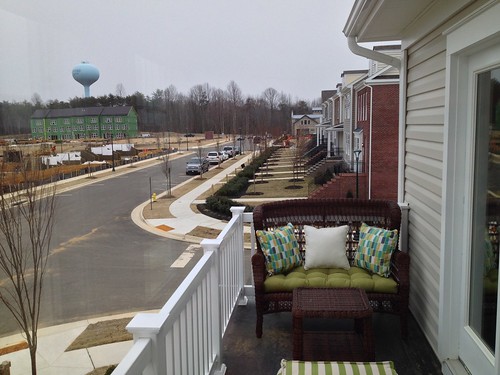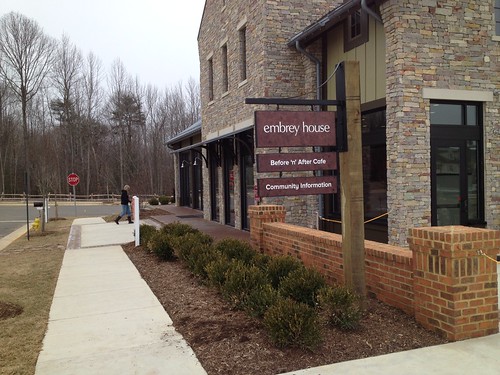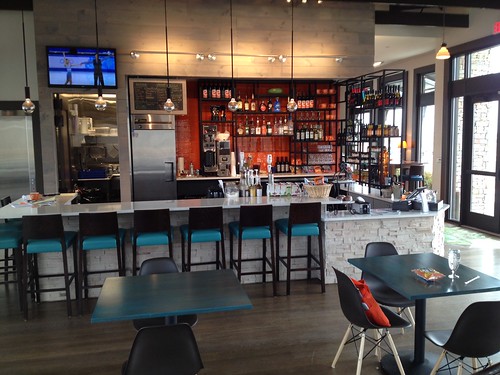There's far more demand for housing in the DC area than supply, especially in urban, walkable neighborhoods. When enough new homes aren't being built close in, the region sprawls further out. In response, new developments on the fringes are adopting urban qualities.
In the Before & After Cafe on Apricot Street one recent Saturday, craft beer was on the menu and the soundtrack included Modest Mouse and Death Cab for Cutie. Outside, light snow fell on a deck with brightly colored Adirondack chairs and an edible garden. Across the street were smart-looking rowhouses and craftsman-style houses with ample porches.
This could be a scene in a trendy inside-the-Beltway neighborhood like Brookland or Del Ray. Except the cafe's empty, the street dead-ends a few blocks away, and the blue water tower overlooking it all says "Stafford, Virginia." This is Embrey Mill, a new planned community being built 60 miles south of DC that promises "a comfortable place at the end of your commute focused on creating a simpler, better way to live."
Like many older neighborhoods, Embrey Mill's master plan envisions a mixed-use retail district, a county recreation center, and public schools within walking distance. The homes take off of traditional styles like you'd see in older neighborhoods; the garages are all in back on alleys, leaving room in front for sidewalks, porches, and a few pocket parks and greens. The streets are arranged in a grid, making it easy to walk around.
Studies show that homebuyers increasingly prefer walkable, urban places. So developers are trying to deliver some form of it wherever they can, whether at Embrey Mill or Brambleton in Loudoun County, the Villages of Urbana in Frederick County, and even Ladysmith Village in Caroline County, 75 miles from DC and 35 miles from Richmond.
The District has grown by 80,000 in the last decade, and the bulk of the region's new residents live there or in close-in areas like Arlington and Montgomery County. But the outer suburbs are still growing quickly as well. Fredericksburg is the DC area's fastest-growing community, while Stafford itself isn't far behind.
For many homebuyers, living in places like Embrey Mill seems like an affordable alternative to closer-in neighborhoods. Prices for a three-story townhouse with a two-car garage start at just $289,000, half as much as a similar home at Crown, a New Urbanist community under construction in Gaithersburg.
While some Stafford County residents work in Stafford or Fredericksburg, thousands still commute to DC or Northern Virginia job centers like Arlington, Alexandria, and Tysons Corner. And the transportation costs of living so far from work often cancel out any savings on the house itself. And there are more affordably-priced neighborhoods inside the Beltway.
A similar townhouse at Arts District Hyattsville in Prince George's County sells for about $30,000 more than the homes at Embrey Mill, is much closer to DC and even Tysons, and is already a walkable, urban place with all of the amenities Embrey Mill promises to have in the future.
Despite its revival in recent years, Hyattsville still struggles with a negative reputation, low-ranked public schools and issues, real or perceived, with crime. Embrey Mill can't beat Hyattsville on convenience, but it can promise new schools and at least the image of a safer neighborhood. So families are faced with a tradeoff.
There are neighborhoods with great schools, easy access to jobs and shopping, and low crime, but they're often prohibitively expensive, and neighbors work very hard to ensure nothing gets built there. Other neighborhoods might have one or two of those things, but require a compromise for the others. And this is just if you're middle class. If you're working class, you have even fewer options.
Our region faces a serious housing crunch in the coming years. According to researchers at George Mason University, the DC area will need 548,000 new homes between 2012 and 2032, or about 27,000 new homes each year. If we can't provide people the housing choices they need, they'll go somewhere else.
We need to create more opportunities for affordable housing in sought-after areas that already have jobs and quality amenities. And in areas that are already affordable, we need to make sure they have the amenities people want so they can draw new residents and investment.
If we push the demand for housing all the way to Stafford County and Fredericksburg, places like Embrey Mill are certainly an improvement over the status quo, since they at least try to offer some basic needs within an easy walk. But if there were more and more diverse housing options closer in, we wouldn't necessarily need Embrey Mill, because people could find the kind of housing and neighborhoods they want closer in.
 |
| View from a porch in Embrey Mill. All photos by the author. |
In the Before & After Cafe on Apricot Street one recent Saturday, craft beer was on the menu and the soundtrack included Modest Mouse and Death Cab for Cutie. Outside, light snow fell on a deck with brightly colored Adirondack chairs and an edible garden. Across the street were smart-looking rowhouses and craftsman-style houses with ample porches.
This could be a scene in a trendy inside-the-Beltway neighborhood like Brookland or Del Ray. Except the cafe's empty, the street dead-ends a few blocks away, and the blue water tower overlooking it all says "Stafford, Virginia." This is Embrey Mill, a new planned community being built 60 miles south of DC that promises "a comfortable place at the end of your commute focused on creating a simpler, better way to live."
Like many older neighborhoods, Embrey Mill's master plan envisions a mixed-use retail district, a county recreation center, and public schools within walking distance. The homes take off of traditional styles like you'd see in older neighborhoods; the garages are all in back on alleys, leaving room in front for sidewalks, porches, and a few pocket parks and greens. The streets are arranged in a grid, making it easy to walk around.
 |
| Embrey House, the neighborhood's welcome center within walking distance. |
Studies show that homebuyers increasingly prefer walkable, urban places. So developers are trying to deliver some form of it wherever they can, whether at Embrey Mill or Brambleton in Loudoun County, the Villages of Urbana in Frederick County, and even Ladysmith Village in Caroline County, 75 miles from DC and 35 miles from Richmond.
The District has grown by 80,000 in the last decade, and the bulk of the region's new residents live there or in close-in areas like Arlington and Montgomery County. But the outer suburbs are still growing quickly as well. Fredericksburg is the DC area's fastest-growing community, while Stafford itself isn't far behind.
 |
| Inside the Before and After Cafe. |
For many homebuyers, living in places like Embrey Mill seems like an affordable alternative to closer-in neighborhoods. Prices for a three-story townhouse with a two-car garage start at just $289,000, half as much as a similar home at Crown, a New Urbanist community under construction in Gaithersburg.
While some Stafford County residents work in Stafford or Fredericksburg, thousands still commute to DC or Northern Virginia job centers like Arlington, Alexandria, and Tysons Corner. And the transportation costs of living so far from work often cancel out any savings on the house itself. And there are more affordably-priced neighborhoods inside the Beltway.
A similar townhouse at Arts District Hyattsville in Prince George's County sells for about $30,000 more than the homes at Embrey Mill, is much closer to DC and even Tysons, and is already a walkable, urban place with all of the amenities Embrey Mill promises to have in the future.
 |
| Traditional-looking single-family homes face a small neighborhood park. |
Despite its revival in recent years, Hyattsville still struggles with a negative reputation, low-ranked public schools and issues, real or perceived, with crime. Embrey Mill can't beat Hyattsville on convenience, but it can promise new schools and at least the image of a safer neighborhood. So families are faced with a tradeoff.
There are neighborhoods with great schools, easy access to jobs and shopping, and low crime, but they're often prohibitively expensive, and neighbors work very hard to ensure nothing gets built there. Other neighborhoods might have one or two of those things, but require a compromise for the others. And this is just if you're middle class. If you're working class, you have even fewer options.
Our region faces a serious housing crunch in the coming years. According to researchers at George Mason University, the DC area will need 548,000 new homes between 2012 and 2032, or about 27,000 new homes each year. If we can't provide people the housing choices they need, they'll go somewhere else.
We need to create more opportunities for affordable housing in sought-after areas that already have jobs and quality amenities. And in areas that are already affordable, we need to make sure they have the amenities people want so they can draw new residents and investment.
If we push the demand for housing all the way to Stafford County and Fredericksburg, places like Embrey Mill are certainly an improvement over the status quo, since they at least try to offer some basic needs within an easy walk. But if there were more and more diverse housing options closer in, we wouldn't necessarily need Embrey Mill, because people could find the kind of housing and neighborhoods they want closer in.

1 comment:
It's an improvement over the Lands of Cul de Sacs but it's a little creepy in the Disney Celebration kinda way.
Post a Comment